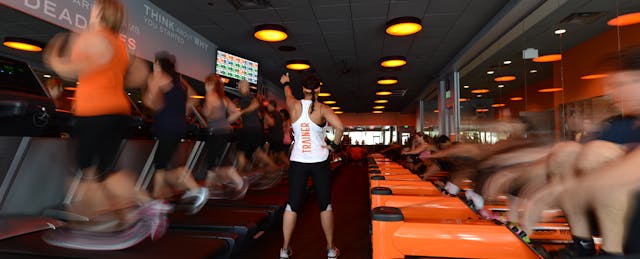We’re now two months into 2017—a good time to set aside the half-priced post-Valentine’s Day candy and check in on our New Year's resolutions. This year, I committed to getting in shape, so my first stop was Orangetheory Fitness, a trendy chain of gyms that provides not only high-intensity workouts and the shot at a six-pack, but also some valuable takeaways for the classroom.
What makes Orangetheory gyms special are their data-driven workouts. Participants move between rowers, treadmills, and floor exercises with heart-rate monitors attached. During the intense one-hour workouts, performance data is projected onto screens that members can watch, getting real-time feedback from personalized tiles that change colors based on heart rate. The stream of data serves as a quick way for participants to make sure they’re maximizing their workout and provides a healthy dose of competition.

While sweating on a treadmill during a particularly grueling workout, it dawned on me how similar the system is to a classroom station rotation, a popular model that allows teachers to meet a wide range of student needs while students work at their own pace. But can the satisfaction of a good workout be replicated in schools? Here are some tips on how Orangetheory’s model might translate to the classroom, strengthening how you personalize student learning.
Engage everyone at the right level
At Orangetheory, workouts are designed to meet members where they’re at, with heart rate targets based on participants’ age, weight, and sex. Two people can be running at different speeds on the treadmill and still meet their respective goals, making the workout challenging regardless of fitness level. In the classroom, try a similar model, allowing students to learn at the appropriate level rather than giving everyone the same lesson and assignment. This way, all students can be challenged rather than being overwhelmed or bored.
Easier said than done? Adaptive online programs like Khan Academy or i-Ready are designed to provide this type of personalized instruction. As students work, the program will determine their strengths and weaknesses and assign differentiated practice. Alternatively, programs like Newsela place the power to choose in the hands of students. Rather than an algorithm, Newsela allows students to self-select articles at their reading level from a digital library. Helping students understand their lexile level allows them to make appropriate choices.
Provide a mechanism for students to monitor progress
One of the most motivating features of Orangetheory is the constant feedback, both from instructors and the monitors. In addition to information about heart-rate, tiles also display calories burned and total time spent in the highest exertion zones. Participants earn points for minutes spent in the top zones of intensity, trying to reach daily targets set by instructors. A quick glance up at the board provides a snapshot of progress and the self-motivation to ramp up effort when necessary.
While we are not going to strap monitors onto students’ brains, students can monitor their own learning in a variety of ways to become similarly engaged. Differentiated online programs usually come with recommendations for skills to master on a daily or weekly basis. Pick something that is easy for students to track, like questions answered correctly, missions completed, or points earned and set goals for them.
At Alpha Public Schools, we worked with the online math program Zeal to set weekly goals for students, like answering 50 questions correctly or mastering two new skills. Since online programs like Zeal provide immediate feedback, students got regular data updates and could track how they were doing. Don’t count out traditional trackers either. Homework stamp charts and test percentage graphs are just a few of the non-tech methods that allow students to monitor their own growth and they can be just as effective. The trick is to provide frequent data on progress.
Think like a fitness instructor
Before Orangetheory participants move through workouts independently, instructors model the proper technique, intervening if participants are doing the exercise incorrectly. It is critical to set similarly clear expectations in the classroom and to model what students should be doing in student-led stations. While this seems to be the norm in most whole group lessons, modeling often disappears during independent work-time, especially when tech is introduced. If students are working on a playlist of activities, provide guidance around whether students should be taking notes or if they are allowed to consult a partner. Check in to make sure students are on task and correct misconceptions as they arise. As this capacity grows in students, you'll be able to spend less time setting expectations and more time on instruction.
Finally, like any good fitness instructor, remember your ultimate job is to help students reach their goals and foster investment. This is especially important in the classroom, where the school day is a lot longer than an hour and students can’t just cancel their membership. Of course, like working out, it's not always easy. But providing personalized goals that students can independently monitor is a step towards getting students that much closer to where they need to be.


